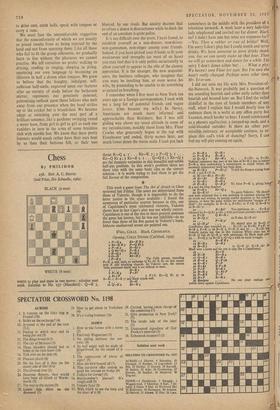Chess
By PHILIDOR
258. Rev. A. C. REEVES (2nd Prize, Die Schwabe, 1962)
BLACK (9 men) WHITE (8 men) WHITE to play and mate in two moves : solution next week. Solution to No. 257 (Mansfield) : Q-B 5,
threat R-Q 4. I . . . Kt-K 7 ; 2 P-Q 3. 1. . . Kt-Q Kt 4; 2 Kt-B 5. x . . . Q-Q 6; 2 Kt.-Q 5 are the thematic variations in this beautiful and subtle half-pin problem. In this week's problem there are three tries with the same basic idea as the correct solution : it is worth trying to find them to get the full flavour of the composition.
This week a game from The Art of Attack in Chess reviewed last Friday. The notes arc abbreviated from those of Vukovic, though it is impossible to do the latter justice in the space available : I found the comments of particular interest because in this, one of Capablanca's most celebrated victories, Vukovic shows that in fact Capa's play was not wholly correct. Capablanca is one of the two or three greatest geniuses the game has known, but he was not infallible-in no fewer than three of his five games in Vukovic's book, hitherto unobserved errors arc pointed out.
White, COLLE. Black, CAPABLANCA.
Opening, COLLE SYSTEM (Carlsbad, 1929) 1 P-Q k4 Kt-K 3 a B 3 P-Q Kt 3 3 P-K 3 B-Kt 2 4 Q Kt-Q 2 P-K 3
5B-Q3 P-I3 4 6 0-ta la-B 3
7 p-rt 3 • • • The Calle system, intending K
P- 4 and, later, to exchange Q Kt for K Kt on that square with K side attacking chances. As Vukovic says, the system 'lacks positional depth' and is not difficult to meet.
B-K 8 P-K 4 PxPl
9 Kix P 9 P x P, Kt-Q Kt 5; to B-Kt r, B-R 3! and black stands well. 0-0 ro Q-K 2 ii1-1( 4
zr 13-B 2 Q-B r 12 P-K 13 4 B-R 3
r3 Q-Q r Kt-B 3 13 . . . nxR?; 14 PxKt. Vukovic comments that part of the idea of B-R 3 was to induce R-B 3, thus undertaking 'a commitment to attack' before the necessary preparatory work has been done. 14 R-B 3 P-Kt 3! To kill the dangers arising from P-K. 5 and B x P ch. rs Kt (2)-Kt 3 Kt x Kt
z6 Kt x Kt B-Kt 2
17 2-K 2 13-11 4 r8 -R 3 Q-B 3! To force P-K 5, giving hint(' Q 4 and the long diagonal.
ro P-K 5 Kt-Q 4 20 Q-B 2? . . To quote Vukovic: 'He should now have admitted that it was pointless to continue playing for an attack and striven, by paying careful attention to the central squares, to keep the game within the well-known "margin of a 13 x Kt ; 21 PxB. Q R-B 1i
draw"; for example, zo B-K 3,
22 B-Kt 3! .. . 20 . . . B x KO Too ambitious. zo . . . P-B 4; followed by P-Q Kt 4-Kt 5 with positional pressure was better. zr PxB Q R-.13 2 22 13-Q r! . . . 22 B else, Q x B ch 1
12 . . . P-B 3!
23 Q-R 4? • 0_ .- He should play 23 B-Q 21 Capablanca then intended 23 . . . KtxP; 24 B xKt, PxP; 25 B-B 3, P-K 5; 26 B-K 2, P-K 6! and 27 . . . R x131 bill Vukovic points out that in this variation White plays not 26 B-K 2? but 26 Q-R 4! with advantage. So Black must play 23 . . . P-Q 3; 24 R-B a , Q-Q 2 with an equal struggle. 23... R-K 11 2
24 B-13 3 Q-B 5
25 B-K 325 Q-B 2?, x B cis I So Black wins a pawn and the rest is easy (for a Capaainca).
25 Kt x B 26 B x13 Kt-B4
27 Q-K 1 R-B 2 28 B-K QxPch zo K-R z4 PxP
3o B x Kt KPxli 3r PxP R-K 2 32 R-K 3 QxKt P 33 P-K 6 Px P
34 Rxl. K-B a 35 Resigns . . . No one plays endings two pawns down against Capablanca.


















































 Previous page
Previous page